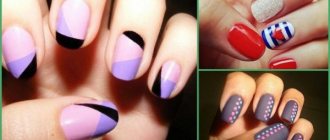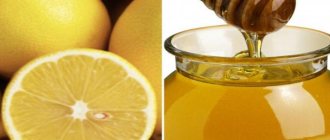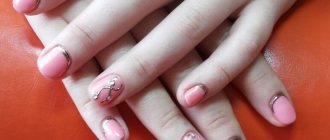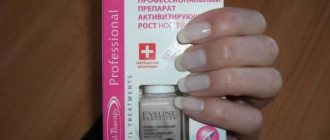At what age can you get nail extensions and why are there restrictions?
The desire for beauty is characteristic of every female. It is noteworthy that the desire to be charming arises at a very early age. Since childhood, little ones have been eyeing their mother's cosmetics. Of course, the first thing that catches your eye is bright and shiny jewelry, including lipsticks, shadows and varnishes. With the advent of nail designs, girls are paying attention to them.
If you can distract little ones with the help of toys, then a teenage girl insistently demands that her nails be done “like her mother’s.” Parents of teenagers often wonder whether it is worth fulfilling their daughter’s request, at what age can they get their nails done without fear of negative consequences.
Age restrictions
It is hardly worth carrying out artificial lengthening at the age of 13. Some people express the opinion that it is already possible to do extensions at the age of 14. Experienced specialists do not recommend carrying out this procedure before the age of 16.
In fact, age should not be considered a criterion from which you can experiment with your own body. Hands decorated with extended nails will look truly impressive only on a fully developed figure.
During adolescence, when a girl turns into a girl (usually from 12 to 16 years), the proportions of individual parts of the body may not correspond to each other. At this time, having coloring on your fingertips is more likely to cause ridicule than admiration. Mothers should explain to their daughters that their desires are premature. It won't be long before fashionable manicures become available.
Everything is very individual, but in any case not earlier than 14 years old.
And there are justified reasons for this, which are still not worth compromising.
Firstly, at the age of 14-17 years, children’s nails are softer and brittle, and much thinner than those of adult girls, and the nail plate is not yet fully formed.
Secondly, until the age of 17, girls’ bodies undergo serious hormonal changes due to puberty. This is a completely natural process, but the hormonal background remains unstable and therefore the extended nails will not hold up well.
Thirdly, at this age, not every young lady is ready to have to take care of her nails. But here it should be noted that there are also very advanced young people who know better than you how gel differs from acrylic, what is the advantage of professional nail polishes over cheap products, what is a buff, and why it is better to use a Kodi nail buff rather than use a nail file the old fashioned way.
Is nail extension harmful? Undoubtedly. Nail extension is far from a useful procedure, and no matter what professional does it, it still does not have the best effect on the quality of your own nails.
It is unlikely that these reasons will be able to stop an intractable teenager, and the desire to try will go away on its own. Therefore, do not worry, 2-3 procedures are unlikely to greatly spoil the young lady’s nails, but you will maintain your good, friendly relationship. And a little time will pass, and your daughter will agree with you that she does not need this at all.
But then the next question you ask yourself will be, at what age can you paint your nails?
Advice to the client about nail extensions
add article
For those who decided to get their nails done for the first time, you need to know some things. They will save your time and keep your nails in excellent condition as long as you wear them.
- Try not to grow long nails for the first time. They cannot be removed like false nails, the moment they get in the way and put on again, until the next visit to the master they will be part of your hands. You need to get used to them gradually. After some time, a couple of days or a week, you will no longer separate yourself and your hands with long nails
- Try to be careful in ordinary situations, for example, when opening the door of a refrigerator or car. Skill will be required when typing on a computer keyboard or using a telephone, and fastening buttons or zippers. Over time, this accuracy will be performed automatically, giving a certain character or even charm to your movements.
- When choosing a design or shape, describe in detail your wishes to the master, tell us what kind of work you often have to do with your hands, be sure to listen to his advice after he looks at your hands. He may recommend not the longest nails for the first extension, perhaps not the shape that you would like to get right away, but you will have to make a decision about what nails you will wear yourself
- Acrylic and gel nails can be removed by contacting a specialist; it is not that expensive, but it takes some time, from 30 minutes to an hour. You can do this even if you don’t plan to build them up, but walk around with your nails after removing them
- Never try to remove nails yourself. You can damage the area where the nail is formed, which can lead to very sad consequences. It may take a lot of effort and time to correct the situation. You may even have to wear extended nails for a long time in order to hide the defect.
- If natural nails grow in an irregular shape (flat, concave or very short), by extending artificial nails, you can straighten their shape and achieve the desired length. For many people, nail extensions help them get rid of bad nail habits and transform the appearance of their hands in one day.
- Do not tap the ends of your nails on hard surfaces, do not use your nails to open anything, do not squeeze or try to bend them. Modern materials with appropriate nail care do not have a negative effect. In addition, your fingers and nails are periodically examined by an experienced master, who can always tell you what to do so as not to harm your nails.
- It is not advisable for pregnant women to have artificial nails, or if you are taking hormonal medications or antibiotics.
The most common Rumors and Myths about nail extensions Myth 1. Nail extensions spoil your natural nails.
Reality: The materials used in extensions do not damage nails.
Both acrylic and gel are safe for natural nails. Nails are damaged by inexperienced, unskilled nail technicians by heavily filing the client’s natural nail. The clients themselves save money on removing and tearing off artificial nails from natural nails along with the top layer of the nail plate, disfiguring the cuticle area with files. While wearing artificial nails, natural nails are in a protected sealed state and are not subject to any aggressive external influences. In most cases, with constant wearing of extended nails, even a damaged natural nail acquires the correct direction of growth and shape, stops peeling and can completely acquire an aesthetic appearance. Extensions are also recommended for those who have a lot of stress on their nails. Myth 2. All masters are the same and do the work the same way and there is no difference where and to whom to go to get your nails done.
Reality: Nail extension is a procedure that requires constant improvement and training from the artist.
Diligence, but at first glance the procedure does not seem complicated. Good masters train for years. Pay attention to the availability of advanced training diplomas. Visiting expensive salons does not guarantee the quality of work. In a salon there is also a much greater chance of running into an amateur or a novice master than with a master at home. As a rule, novice masters go to the salon to work. And most importantly, there is no good nail technician who can do nail extensions for 3 kopecks. Myth 3. Is gel better than Acrylic or vice versa?
Reality: I wonder who started the rumor among the masses that gel is better than acrylic and does not damage the nail.
Acrylic and Gel belong to the same group of chemicals. Acrylates. Myth 4: Extended nails require frequent and difficult care.
Reality: Artificial nails require maintenance only once every 2-4 weeks (correction).
On extended nails, even the cheapest varnish lasts an average of 2 weeks. With artificial nails, you are much less likely to have to do a trimmed manicure with steaming. Dirt collects under such nails less often, and you can forget about hangnails altogether. Myth 5. You can’t fiddle around in water for a long time, do laundry, wash dishes or floors, etc.
Reality: All this can be done, many advise wearing gloves, and this will protect not only your nails, but also the skin of your hands from harmful caustic substances, but washing dishes and without gloves it does not cause much harm.
Myth 6. Natural nails do not breathe under acrylic/gel.
Reality: The very concept of “breathing” is no longer true.
Even an ordinary person who knows how to think logically will understand that this is not so. Nails are keratinized tissue that allows moisture, fat, etc. to pass through small pores. Nail nutrition occurs in the matrix, in the area under the cuticle, and through capillaries, so just use cuticle oil, drink vitamins and your nails will receive the necessary nutrition and be healthy ! Myth 7: Artificial nails break quickly.
Reality: In fact, extended nails are very strong and very difficult to break, provided, of course, high-quality materials and a good master.
Exceptions: excessive sweating of the hands, pregnancy, taking hormonal medications (including contraceptives). So if the material begins to peel off, crumble, or does not stick at all, look for a problem in the master or in your health. Myth 8: Extended nails require frequent and difficult care.
Reality: Artificial nails require maintenance only once every 2-4 weeks (correction).
On extended nails, even the cheapest varnish lasts an average of 2 weeks. With artificial nails, you are much less likely to have to do a trimmed manicure with steaming. Dirt collects under such nails less often, and you can forget about hangnails altogether. Myth 9: Extending toenails is nonsense.
Reality: In fact, toenail extensions can solve the problems of many women.
Of course, we mean problem nails. In addition, such a service can be very useful in the summer, when you want to look perfect. Moreover, it is even easier to care for extended toenails, and for those who have good toenails, you can simply seal them with gel, either colored or in the form of a “French manicure.” This coverage will be enough for 5 weeks for sure, or even more. Nail correction, what is it for?
Nail correction is important!
Nail correction is an important procedure that should not be neglected. During it, material is added to the nail area, next to the cuticle, the smile line is raised (if possible), and the beautiful shape of the nail is restored. It is very important to observe certain time intervals between corrections, which should be about 2-3 weeks. This period is explained by a certain growth rate of natural nails. If correction is carried out during the procedure, this will avoid deformation of the material, ensure the stability of artificial nails and require a minimum of time and expense. Thus, when applying nail extensions, it is necessary to carry out corrections regularly. Sealing techniques may be used during the procedure. Correction is necessary due to the fact that after extensions the nail grows, and after a while the hole area ends up without the material used (gel, acrylic), the nail tip becomes longer and, as a result, there is a risk of breaking it off. Nail correction is carried out efficiently, but requires at least 1 hour. There should be no visible discharge of material. In case of detachment, it should not be more than 1 - 1.5 millimeters. Even in this case, you need to think about whether the material used is chosen correctly. In addition, the cause of detachment may be careless handling of nails, the use of active alkaline products in everyday life, a large length of the free edge, exacerbation of various chronic diseases, and the use of antibiotics. Why does nail peeling occur?
You got your nails done...
You are happy that your nails are now like an example of beauty and grace. But very little time passes and you begin to observe that your nails begin to peel off. You get upset and start scolding the master. After all, you place all the blame for detachments on the master. But is the master always to blame here? But according to statistics, quite often extended nails peel off in the very first days. But the master has absolutely nothing to do with it. Other reasons play a role here. Which? Below we provide a list of small rules and tips:
- A few days before the procedure, try to wet your nails as little as possible. The main task is to make the nail plate less saturated with moisture.
- The procedure should be canceled if you feel unwell. After all, if you took hormonal or antibiotics, it is because of these drugs that detachment may begin in the very first days.
- If you are pregnant or already breastfeeding, this procedure is definitely not for you right now. A special hormonal background will be to blame for the detachments.
- If you have high humidity on your hands, warn your technician in advance - this feature can sometimes lead to rapid detachment of nails.
- have you started your period? – it’s better to wait a few days and only then go for the procedure. After all, it is known that these days it is not recommended to paint or extend nails.
You see, there are a number of reasons why nail peeling occurs, and the master has nothing to do with poor-quality work. Most likely, the layers depend primarily on you. After all, if you learn these simple rules, your extended nails will last you longer than usual and will delight not only your eyes, but also the eyes of the people around you.
Kagramanyan Christina
|
18.11.2011
|
Vote:
Tags: nail extensions
- History of nail extensions
- Facts and lies about nail extensions
- All about nail extensions
- Types and technologies of nail extensions
- Gel modeling on forms
Discussions on the forum on the topic:
- Nail extensions
- "Crystal" nails
- Nail extension materials
- Contraindications for nail extensions
- Nail extensions at home
When do experts recommend nail extensions?
When classical methods of combating the habit of biting nails do not help, manicurists can offer nail extensions. Regarding the age at which a girl can have her nails extended, experts do not have a clear distinction. It all depends on the quality of materials and the qualifications of the craftsman. But in general, it is recommended to limit the use of extension materials to those under twelve years of age.
Sometimes the nails become injured and cause pain to the child. In this case, you can restore the nail plate, but not increase the length. This will not be a decorative coating operation. Rather, it is nail prosthetics. It is necessary to monitor the condition of such a nail: file the length in time, remove the thickness of the coating as it grows. In a month, most likely, the nail will heal completely and there will be no need to apply any more artificial material.
Experts' opinion
If you ask several masters about the age at which nails can be extended, the answers will be different. But experts are unanimous on one thing: there is no clear answer. Growing up is different for everyone, which means that access to cosmetic procedures is available individually for each girl. However, under any circumstances, under 14 years of age, you should not resort to nail correction in the form of nail extensions.
During adolescence, children's nails are soft and more brittle. The palms still continue to grow, and with them the growth of the nail plates occurs. Serious interference with this natural process is unacceptable.
It is also important that during puberty, girls’ hormonal levels change significantly. Due to its instability, there is a high probability of false nails being rejected by “relatives”. Overlay plates will not last long.
Another argument against the fashionable procedure is that young ladies are not yet accustomed to caring for their hands. In addition, sudden movements, including during physical education classes, inevitably lead to breakage and other defects in beautiful pads.
Taking into account all the negative consequences, specialists who are responsible for their work refuse to lengthen the nail plates of too young people. The service is performed exclusively with the consent of the parents.
Is it dangerous to get a manicure?
At first glance, the procedure for applying gel polish looks quite harmless. But there is some harm from salon and home nail treatments.
Why is nail dust dangerous during manicure?
Before applying fresh gel polish to your nails, you must remove the old coating. If the procedure is performed using hardware or a file, tiny dust inevitably rises into the air. It consists of particles of the nail itself and a frozen substance. When you inhale, a certain amount of suspended matter enters the bronchi and lungs. Over time, this leads to the development of chronic diseases.
The harm of nail dust is that it causes allergies, bronchitis and asthma. Advice! You can protect yourself from nail dust using a medical mask. In good nail salons, the technician has a special vacuum cleaner on his desk.
Is the smell of nail polish harmful?
Any gel polish has a sharp and not very pleasant aroma, which is emitted by the chemicals included in its composition. Prolonged inhalation of this odor causes poisoning and provokes nausea, headache, increased heart rate and a feeling of lack of air. The harm is that the toxic vapors of the varnish dry out the mucous membranes of the nasopharynx and can lead to allergic rhinitis.
Doing a manicure at home or in a salon should be done with good ventilation. To reduce the health hazards of gel polish, you should choose products with a minimum content of toxic substances when treating your nails.
Is a lamp harmful for manicure and drying gel polish?
When applying gel polish in a salon, ultraviolet lamps are used to quickly dry it. Their health safety remains a controversial issue.
On the one hand, ultraviolet treatment lasts a matter of seconds, and the radiation does not have time to cause serious harm to the skin. If there are modern lamps in the salon, regular annual procedures in terms of the degree of danger can be equated to one ten-minute walk in the sun.
However, the negative health consequences of gel polish and drying become more significant in the presence of moles on the hands, especially those that have a risk of malignant degeneration. In such cases, it is better to refuse this type of manicure due to the potential harm. Even minor additional UV radiation increases the likelihood of moles becoming malignant.
Harm of hardware manicure
Correction of the nail plate before applying gel polish can be done not only manually, but also using hardware. In this case, the procedure takes place without preliminary steaming of the cuticle, which is more useful for dry skin types.
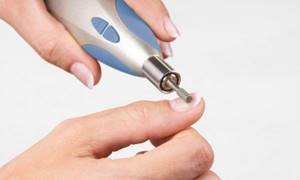
In inexperienced hands, a manicure device can leave burns on the nail.
But at the same time, manicure using a special device should only be performed by a very experienced master. Reviews claim that unqualified specialists can cause serious harm. Cuts and abrasions remain on the skin, ridges appear on the nails, the plates begin to peel and crack, and the condition of the cuticle deteriorates.
Harm from chemical fumes for manicurists
Chemical fumes from harmful components of gel polish are dangerous for the artist in the same way as for the client. The specialist suffers even more from inhaling toxic compounds, since he is forced to come into contact with them throughout the whole day.
If there is no ventilation in the cabin, constant poisoning with chemical vapors can lead not only to the development of allergies in the technician. The risk of severe diseases of the heart, central nervous system and respiratory organs increases.
Is it dangerous to get a manicure in a salon?
The undoubted advantage of salon procedures is the speed and quality of nail treatment. But along with this, there are several dangers of manicure for clients:
- Infection. If the instruments are not properly disinfected, you can catch any infection or fungus in the salon, as well as very dangerous diseases - from HPV to hepatitis and HIV. Such cases occur infrequently, but are still recorded by statistics.
- Injuries. If the technician is poorly qualified or simply made a mistake, a painful and difficult to heal cut or burn may remain on the finger.
Attention! To get a high-quality and safe manicure with gel polish, it is important to choose not only a good salon, but also a specific specialist with a diploma and positive reviews.
The fashionable procedure is not harmless
In most cases, extensions are performed solely out of a desire to show off.
Meanwhile, the procedure was initially conceived as a practical operation that could hide:
- uneven surface of the nails;
- their separation;
- fragility and dullness;
- unsightly shape.
The method used to solve problems turned out to be so good that it quickly became fashionable. Today, jewelry on the tips of the fingers can be seen on schoolgirls and students, middle-aged ladies and pensioners.
Following fashion trends makes young people quickly become owners of beautiful artificial nails. Few people think about the negative consequences of the procedure. And they exist. And more damage is caused to girl’s marigolds that are not yet strong.
Violation of the natural surface layer of the nail can lead to a lot of troubles and even diseases. If the nail is cut deeply, it may not recover completely. Fungus and bacteria can penetrate into it through a damaged structure. Getting rid of fungal diseases is not easy. They can develop into a chronic form and remain for many years.
In addition, the unstable hormonal background of growing girls can play a bad joke on them. The body is unable to adequately respond to nail extension materials. Severe allergic reactions to chemicals are often observed. Swelling, itching, burning or inflammation appears.
The applied gel is dried under the rays of an ultraviolet lamp. Not everyone will like this procedure. The local targeted effect of ultraviolet radiation can also cause harm to young women with fragile hormonal levels.
Nail extension process
To understand why this procedure is prohibited at an early age, it is worth familiarizing yourself with its implementation. First, the master performs a traditional manicure. At the same time, cuticles are pushed back and removed, and the nail surfaces are cleaned. In principle, such actions do not cause harm, but on the contrary are very useful. But, after this comes the stage of sawing off the upper layers of the plate. It is strictly contraindicated to do this at a young age.
If cutting is carried out carelessly, too many layers can be removed. With such actions, the master disrupts the entire structure of the nail and nail bed. And in the future it will be very difficult to restore your nails. In addition, various fungi and bacteria very easily penetrate through the too thin layer of the plate. Often, fungal infections become chronic and accompany a person throughout his life.
Nail extensions involve the use of extension materials - acrylic powder or gel. At the age of 14-16, teenagers go through puberty and a hormonal surge. During the application of extension material, due to hormonal changes, the body may have a serious allergic reaction:
- Hives;
- Atopic dermatitis;
- Eczema;
- Itching;
- Burning;
- Swelling;
- Inflammation.
Therefore, you need to wait until puberty, and only then can you resort to the procedure of nail extensions. Also, hormones can have harmful effects when exposed to an ultraviolet lamp. And gel nail extensions necessarily involve the use of such a drying lamp. Therefore, before you run to the nearest beauty salon, be sure to check all the pros and cons.
Rules for teenage manicure
To teach a girl or boy to keep their nails clean, tidy and not bite them, you can hygienically treat the nail plate at home or in a salon. The rules here are simple.
- For young children and teenagers, an unedged manicure is recommended, which causes minimal damage to the nails.
- The cuticle is rarely processed. If it is damaged, carefully remove it with nail scissors.
- You can cover your nails with a special colorless or thin layer of the most harmless varnish. Painting nails with gel decorative derivatives is unacceptable.
The question at what age can you use gel polish without harm to health has a clear answer - after the end of the transitional period of maturation of the body, that is, after 16 years. Such manipulations with nails are prohibited for children.
Does your daughter ask you to give her a manicure and paint her nails? Read how to perform a children's manicure correctly and beautifully.
Today, children's manicure has become a popular service in beauty salons. A similar procedure can be carried out at home. Fortunately, master classes and ideas for children's nail design are a dime a dozen. All that remains is to figure out at what age and what age children can get manicures.
Nail care issues
Children are given manicures from birth - mothers make sure that the baby’s nails are well-groomed, moderately short, and do not curl or scratch. And usually, until the age of 8-10, girls are quite satisfied with such hygienic care for their fingers. But then questions arise about whether it is possible to paint nails, grow them, or extend them. Most mothers immediately begin to object, but do so without thinking much about how justified their objections are.
Experts say that it is better to wait as long as possible with manicure (in the adult sense).
It is believed that each age should have its own manicure innovations.
- Until the age of 6 , nails are only trimmed; it is better to push back the cuticle with an orange stick and do not cut it.
- before the age of 14 , because dirt and bacteria accumulate under them, and a girl under 14 is unlikely to be able to adequately care for her nail plates without negative consequences.
Other secrets of beautiful hands (extensions, gel polish) are better left for a later age.
The nail plate of children and adolescents is more vulnerable, thin and vulnerable. It is very easy to damage it through improper procedure or insufficient care, while treatment of the nail plate can take quite a long time.
At what age can you get manicures and nail extensions?
Girls very often want to be attractive and spectacular, like mothers and other women, but their desire to get a manicure does not always find understanding among adults. In the USSR, painted nails were generally prohibited in schools - it was considered not only unethical and immodest, but also harmful to children's health. Today, pediatricians are not so categorical, but still the answer to the question of at what age can a girl get a manicure and have her nails extended remains not entirely clear. Let's try to answer it.
Is it harmful to paint your nails with nail polish?
It is not only the dyeing procedure and its individual stages that can cause harm to health. Decorative coatings themselves pose a certain danger to nails.
Recommended reading: Foods that lower testosterone in women and men
Is regular nail polish harmful?
When choosing a nail polish, you need to carefully study its composition. Many budget substances contain toluene and formaldehyde, which cause harm. The first causes oxygen deficiency in tissues, and the second negatively affects immune and nerve cells.
Although there is little contact with nail polish when painting nails, chemical fumes are still harmful to health. In addition, cheap products with frequent use can cause delamination of the hard plate and deterioration of its structure.
Is a manicure with gel polish harmful to health, how does it affect nails?
How harmful gel polish is depends on its composition. In any case, the product contains toxic chemical components, the difference is only in the proportions. The dye contains the following dangers:
- formaldehyde, which can lead to dermatitis, chemical burns and heart rhythm disturbances;
- toluene, which causes nausea, weakness and fainting;
- dibutyl phthalate - the danger of this flavoring is that it can lead to the development of endocrine disorders.
To reduce damage from harmful substances in gel polishes, it is recommended to choose formulations from well-known European brands. They pay great attention to the environmental friendliness of their cosmetics.
If the evaporation of gel polish is dangerous to health in general, then the nail plates receive contact damage even from the highest quality product. Due to constant wearing of manicure, they become thinner and brittle, sometimes acquiring a yellowish color.

Gel polish forms a very dense coating that does not allow oxygen to reach the nail.
Is gel polish harmful during pregnancy?
Despite the certain harm of gel polish for human health, pregnancy is not a strict contraindication for performing a manicure. However, a pregnant woman must take into account that vapors of dyes have a negative effect not only on her body, but also on the fetus. The poisonous effect is very weak, most often does not cause serious harm, and yet it is advisable to avoid it. In addition, in the early stages, the smell of gel polish can provoke increased toxicosis.
Shortly before giving birth, doctors also recommend avoiding manicures. First of all, to monitor a woman’s condition, doctors need to see the real color of her nails; it changes as her health worsens. And directly during childbirth, pulse sensors can be attached to the fingers. Their accuracy will be maximum if there is no coating on the nails.
In case of hepatitis B, harm from gel polish for a child can be avoided if the manicure is performed with good ventilation. In this case, toxic volatile substances will not be able to pass through the respiratory system into the bloodstream, and from it into the mother's milk.
Is it harmful to apply gel polish to your nails all the time?
Proof of the harm of gel nail polish is that with continuous use it dries out the plates and makes them thinner. This leads to the appearance of microcracks in which fungus can form. Most often, the problem is faced by women who have naturally weak, brittle nails.
If after the next removal of gel polish the plates seem painful and look bad, you need to temporarily abandon the manicure. Nails are allowed to be coated only with medicinal compounds until complete recovery.
Is it harmful to remove gel polish?
When removing the coating, damage to the nails can occur, especially if the plates are weak or the procedure is carried out by an inexperienced nail technician. When sawing, there is a risk of injuring or burning the tissues themselves. To carry out the procedure, you need to choose a qualified specialist. Many good nail technicians, when removing a manicure, prefer not to touch the base coat if it is well adhered to the nail, and only polish it before applying a new layer of gel polish.
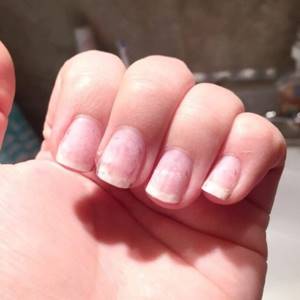
Harm from removing gel polish can manifest itself in unsightly white stripes and spots
Is it harmful to remove gel polish with liquid?
In addition to sawing, soaking in a special solution is used to remove the coating. The technology shows good effectiveness, but is harmful to nails and cuticles. Most solvents are made based on acetone, which dries out the skin and plates, worsens their appearance and provokes the development of diseases.
Is nail polish, gel polish harmful to children?
There are no strict age restrictions for getting a manicure. But using gel polish is still not recommended for children under 14 years of age. The plates at a young age still continue to form; they are thinner, weaker and softer than those of adults. During this period, covering your nails with gel polish is harmful. They can be damaged by treatment before painting, by the decorative composition itself with toxic chemicals, and by its subsequent removal.
Doctors and cosmetologists advise using only water-based products for children's nails. They do not cause harm and are also very easy to remove from the plates.
Attention! Before performing any children's manicure, you should consult with a pediatrician and find out if the child has any contraindications.
At what age can you paint your nails?
Unfortunately for many mothers, the question of at what age can children paint their nails seems completely ridiculous. And they don’t see anything wrong with painting their little daughter’s nails with nail polish. This often happens even in kindergarten. And in vain. In fact, the varnish contains many harmful components, such as formaldehyde, toluene, camphor, etc., which have an extremely negative effect on the fragile body of a child, albeit in a small volume.
This is not life-threatening, but what is the point of harming the health of your child in such a way, and at such an early age, when the desire to paint your nails comes more from the parents themselves than from the baby. In such cases, it is almost impossible to convince parents, therefore, we can only advise them to use water-based varnishes. Such varnishes, of course, cannot boast of their durability; they are washed off with water, but they are practically harmless.
In addition, there are types of varnishes that do not include the most dangerous components:
- 3-Free, does not contain formaldehyde, toluene, dibutyl phthalate
- 5-Free, does not contain formaldehyde, toluene, dibutyl phthalate, formaldehyde resins, camphor
- 10-Free, if you believe the manufacturers’ statements, they do not contain not only harmful substances, but also fragrances.
Paint your nails - when and how?
Today, no one will be surprised by a photo of a kindergarten student with brightly painted nails (for example, for a holiday). Mothers themselves paint their daughters’ nails, not taking into account that the composition of nail polishes is quite dangerous and can negatively affect the health of their children. Thus, toluene and formaldehyde contained in decorative coatings are especially dangerous. Even small amounts of these substances have a pronounced carcinogenic effect.
But the admonitions of pediatricians often remain unheard, misunderstood, and ignored by adults. In this case, you must remember that only water-based varnishes are suitable for girls. They are not permanent, they are quite easy to wash off with water, they will not harm the child.
It is not recommended for girls to paint their nails until they are 11-12 years old. The fact is, and any woman knows this, that before applying varnish, the nail plate must be treated, and for a thin and vulnerable plate of a girl under 11 years of age, this will not be beneficial.
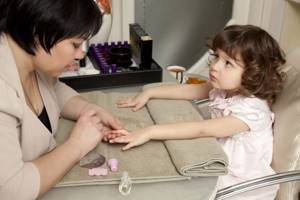
At what age can you get nail extensions?
- Mom, can I get my nails done? My daughter stumped me with her question. Frankly, I was simply not ready for such a question, because for me she was still a little girl. Of course, I automatically tried to object, but arguing with a teenager turned out to be not so easy. And for every no, she had several counterarguments. And in the end I had to give up, throwing up my hands in confusion.
On the one hand, I understood that there was nothing useful for a teenager in wearing makeup, and especially in nail extensions. But on the other hand, I was already delaying this moment as much as possible. All the girls in the class have long tried both extensions and gel polish. Well, how can you resist the new fashion when all your girlfriends are constantly posting photos on Instagram with a new manicure.
This, of course, is not a reason to change your point of view, but spoiling your relationship with your daughter, especially during such a difficult period for her, puberty, is also wrong. Therefore, to begin with, I decided to find out, at what age can children get nail extensions? And to understand for yourself how weighty the arguments against are, maybe everything is actually not as scary as we imagine?
Is it possible to get nail extensions for pregnant women?
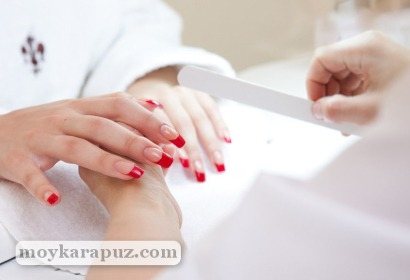
The procedure is considered a relatively new technique. Therefore, its effect on the body of the expectant mother and the developing fetus has not been fully studied. The main questions concern the influence of chemicals used during the session:
- glue for tips;
- antiseptic;
- primer;
- finish gel;
- modeling gel;
- acrylic paints.
The materials emit volatile substances that spread throughout the room and are inhaled by everyone present. Gynecologists have not yet developed a consensus regarding prohibitions on nail extensions while bearing a child. But most of them still recommend refraining from the procedure, at least in the first 12 weeks.
There is an opinion that it is better for pregnant women to use gel for extensions, since it is odorless. However, when cured, the material evaporates in the same way as acrylic, so the opinion about its safety is erroneous.
Advice from manicurists
Children's manicure differs from adult manicure in the use of gentle products containing natural ingredients. A master who works with adults can also perform procedures with children, knowing a few tricks.
First, they examine the hands and ask the parents about the absence of allergies to various substances and drugs. Little clients' hands are treated with nail disinfectant.
Children's nails contain a lot of water; work with them carefully. For a visual effect, purchase a figured nail file with a child's drawing.
Not all children are comfortable with the vibration of the file, so sometimes you have to use scissors or nippers instead.
Do not cut your nails too short to avoid injury.
If the child’s nail plate is peeling, a vitamin strengthening coating is used. Then apply 2 layers of varnish of the selected color.
You can stop your child from biting his nails with a bitter-tasting preparation designed to coat nails.
Manicure for children 10 years old uses a simple design with bright elements. Stickers and drawings are used, especially in children's summer manicure. Drawing on a small children's plate is difficult; it must be done quickly, until the little client gets tired of sitting quietly in one place. The master should have special brushes in his arsenal for mixing paints, applying dotted elements, fine lines and small details. All this will help create what the children think is cool decor and design.
Is a manicure with gel polish harmful during pregnancy at different stages?
The fetus developing in the womb requires certain vitamins and minerals. The child takes these substances from the woman’s body, and she may experience problems with the condition of her hair, brittleness and splitting of her nails. You can solve this situation with a manicure with gel polish.
Coating the nail plates with gel compounds in itself is not dangerous. The threat is posed by chemical vapors that enter a woman’s body through the respiratory system. Thus, they enter the mother’s blood, and then into the placenta. Components of gel polishes that pose a hazard if inhaled:
- formaldehyde (improves the adhesion of the gel to the nail plate, has a pungent odor, causes headaches, rapid heartbeat in a pregnant woman, can cause developmental defects in the fetus, abnormalities in the immune system, allergies, damage to the nervous system),
- camphor (although it is a natural plasticizer, which is widely used in medicine, if it enters the respiratory tract of a woman who is expecting a child, it can cause uterine hypertonicity and has a negative effect on the functioning of the cardiovascular system),
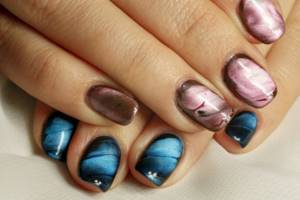
- toluene (the main function of the compound is to increase the service life of the coating, while entering the woman’s blood through the respiratory system, it has a teratogenic effect on the embryo),
- butylated hydroxyanisole (BHA) is a preservative that provokes the formation of cancer cells.
Before a manicure, a woman should ask the nail technician about the composition of the coatings used. If these components are present in them, it is better to refrain from such a procedure, especially in the early stages of pregnancy, so as not to harm the baby.
Should children get a manicure?
Every mother begins to carefully trim her nails from the birth of her child, so a hygienic manicure is included in the list of routine self-care procedures. Treating your baby’s nails comes down to cutting the nail plate and getting rid of hangnails; you can also carefully push back the cuticle if you wish, but trimming a manicure is not recommended.
As for the so-called nail design, which can be performed after a hygienic manicure, the salon will offer you such a service if the child is already 5 years old. A fashionista will probably be delighted with the design on her nails; it is clear that special children's water-soluble varnishes are used for this, and applying regular varnish, not to mention shellac or gel varnishes, is out of the question.
It is worth taking your child to the salon at an early age, if only because such a procedure will help get rid of the bad habit of biting nails, and at the same time teach the baby to be neat.
Contraindications for pregnant women
A manicure using shellac is not suitable for all pregnant women. Contraindications to the procedure:

- fungal nail infections,
- injuries or severe delamination of the nail plates,
- allergy to individual coating components,
- taking antibiotics.
If a woman has no contraindications, applying gel polish is allowed. Doctors emphasize that it does not cause obvious harm to expectant mothers.
Caring for extended nails
Long nails require special attention. There are certain rules of conduct for those who build them up. For example, doors should be opened carefully, clothes should be put on slowly, and zippers on purses and shoes should be carefully unzipped. You will have to give up ball games: volleyball, basketball, handball. And it is better not to engage in other sports to avoid damaging your fashionable jewelry.
Active teenagers have not yet mastered the art of controlling their own bodies. Only towards the end of the formation of the feminine principle, and this happens in most cases by the age of 17, do movements become smooth. Only then comes the time to show yourself in full glory. In the last grades of school, girls gain experience in caring for themselves, and long nails will decorate their owners and not interfere with their daily activities.
Any, sometimes even minor, loads are reflected on the nails. Cracks, creases, and bends appear. It's a shame when an artificial part breaks. And it’s very painful if, along with a beautiful record, the “live” one breaks and comes off. It will take more than one month for the injured area to heal. You'll have to wait for your nail to grow back. You can forget about the former beauty at this time.
The procedure of nail extensions is associated with certain risks.
What to choose: to dare the procedure, to do a traditional manicure, or simply to use gel polish without extensions is, of course, up to the girl herself to decide. But parents are simply obliged to warn their daughter about all possible troubles.
The benefits of manicure for women
Although manicure can be harmful, it is necessary to note the beneficial properties of gel polish. In some cases, coloring and augmentation procedures improve the health of the plates.
What are the benefits of gel nail polish?
The effect of gel polish on the body is not always negative. Some manicure compositions belong to the medicinal category; they contain oils, mineral components and vitamins that strengthen nails. Using this type of gel polish is useful for brittle and cracking plates. The product transforms nails, restores their structure and smoothes the surface. Therapeutic gel polish can be used as a base for a decorative coating. In this case, it will prevent direct contact of the toxic composition with the plate and reduce potential harm.
Many women, even with weak nails, prefer gel polish to a regular manicure or lack thereof. The coating gives your hands a very beautiful and neat appearance; problems do not go away, but they cease to be noticeable.
The benefits of nail extensions
Gel or acrylic nail extensions can also provide benefits. In particular, they:
- remain neat for a long time and help to avoid the need for constant updating of a regular manicure, which in one way or another harms the plates;
- allow you to adjust the outline of the hand - extensions are especially useful for those with short fingers and wide nails, since visually the palm becomes longer and more graceful;
- help get rid of bad habits - not only children, but also many adults continue to chew their own fingers, whereas this is impossible to do with extended plates.
Artificial nails require careful handling and are quite easy to break. But this is precisely why a woman begins to carefully monitor and care for her hands.
The benefits of Japanese manicure
Japanese manicure is a set of useful restorative procedures that are especially recommended after nail extensions. The technology does not cause any harm and consists of several stages:
- softening and removing cuticles;
- plate polishing;
- treating skin and nails with special restorative powder and serum with natural extracts;
- applying a base coat with ceramides;
- hand massage using hot bags of herbs;
- applying a nourishing mask and cream.
The positive effects of therapeutic manicure using Japanese technology help strengthen nails, stop their delamination and eliminate brittleness.
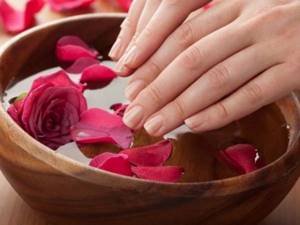
Japanese manicure is a nail SPA Attention! To obtain noticeable results, you need to undergo at least eight procedures. A single session of Japanese manicure will not bring a significant effect.
